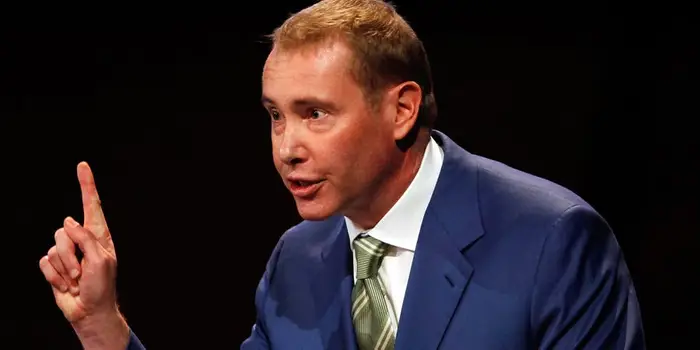A 33-year-old who built up a 6-figure net worth through ‘lazy investing’ says even though 2022 was a ‘a decidedly bad year for investors,’ he didn’t change his investment strategy. Here’s what his portfolio looks like, including the single stock he owns.

- Jesse Cramer built up a six-figure net worth through what he calls “lazy investing.”
- His strategy is simple: He buys diversified index funds and holds onto them, regardless of market conditions.
- He also owns one individual stock: Berkshire Hathaway.
According to Jesse Cramer, “2022 as a whole was a decidedly bad year for investors.”
The S&P 500 fell 20% in 2022, its worst year in more than a decade.
Cramer works full-time for a registered investment advisory firm while also maintaining a personal finance blog, The Best Interest. After paying off $42,000 in debt, he became serious about investing and amassed a six-figure net worth through “lazy investing” while saving for his first home.
Despite market volatility over the last two years, “my investment strategy has not changed,” Cramer told Insider. “The main reason is that my primary financial goals have not changed.” My primary goal is to save for financial independence and retirement.”
When it comes to investing, he follows the framework of “goals then timelines then asset allocation,” he explained. “Because my goals haven’t changed, neither have my timelines.” I’m still thinking about decades in the future. And because my timeline hasn’t changed, neither has my asset allocation — the percentage of stocks, bonds, and alternatives that I own.”
If his goals change, he may reconsider his asset allocation, but a market downturn isn’t enough to change his strategy, he says.
He reacted to the 2022 downturn in the same way he did to the 2020 stock market crash: apathetically.
“I was well aware of how market downturns work. “I knew they were possible, and I also knew we were overdue for one,” he said of the 2020 crash. “So, when it happened, I didn’t have a particularly emotional reaction.” I sat there and watched it unfold before my eyes like a science experiment.”
Building wealth the ‘lazy way’
Cramer’s investing philosophy is straightforward: “Own a few funds, keep costs low, keep it diversified, and then rebalance on a regular cadence,” he says.
He even refers to it as “lazy.”
He explained that anyone can replicate his strategy by purchasing and holding a couple of low-cost, diversified funds, such as a broad US stock index fund and a broad international stock index fund: “Those two funds give me all the stock exposure I need.” After that, perhaps two bond funds and an alternative asset fund.
“The idea is that I don’t want to have 27 different ticker symbols in my portfolio with all these different percentage fractions to make up 100%.” I’d rather keep it to a manageable number, like three or five.”
When it comes to specific funds to add to your portfolio, Cramer recommends a total stock market index fund such as VTFAX, FSKAX, or SWTSX. These are total stock market index funds from Vanguard, Fidelity, and Schwab.
“It doesn’t make a difference which one you own,” he explained. “Those are the three big ones. They’re all fantastic, in my opinion.”
Obsessing over minor differences, on the other hand, “adds a problem to investors’ minds that is not worth pursuing,” he added.
Periodic rebalancing is another component of the lazy investing strategy. “Say my target allocation is 70% stocks, 20% bonds, and 10% alternatives, and market performance over the last six months has moved my assets into slightly different percentages,” Cramer said. So I sell a little here and a little there to get back to the 70-20-10.”
He prefers to rebalance every year at the same time. That way, it’s “rules-based,” rather than market-driven, he says.
“It should be very mechanical,” he recommended. “Make a calendar reminder for once a year or twice a year. It shouldn’t be more than four times a year because the ‘lazy investing’ becomes too hands-on.”
Owning one individual stock: Berkshire Hathaway
Cramer does not believe in picking individual stocks, but he does own one, Berkshire Hathaway.
“I’m not afraid to admit that my ownership of Berkshire Hathaway is rooted in an irrational decision,” he said. “I really enjoy listening to Warren Buffett and Charlie Munger talk, and I think it’s fun to own the company that they run.” “It’s really that easy. It is not a fundamental decision based on in-depth stock analysis.”
All investments involve some level of risk, but betting on a single stock is inherently riskier than owning a mutual fund, which combines several stocks into a single investment.
“I’m fortunate that my ownership of Berkshire Hathaway has worked in my favor — that is, Hathaway has consistently outperformed the rest of the US stock market since the time I bought it,” he said. However, “that’s just dumb luck.”
The fact that the company has done well is an added bonus. He didn’t buy it to make money, he explained, comparing it to purchasing a designer handbag or a signed rookie baseball card. You own it because you enjoy having it, not because it is the most fiscally responsible thing to do.
“Even if I lost 20% of my investment money, I’d still enjoy owning it.”






